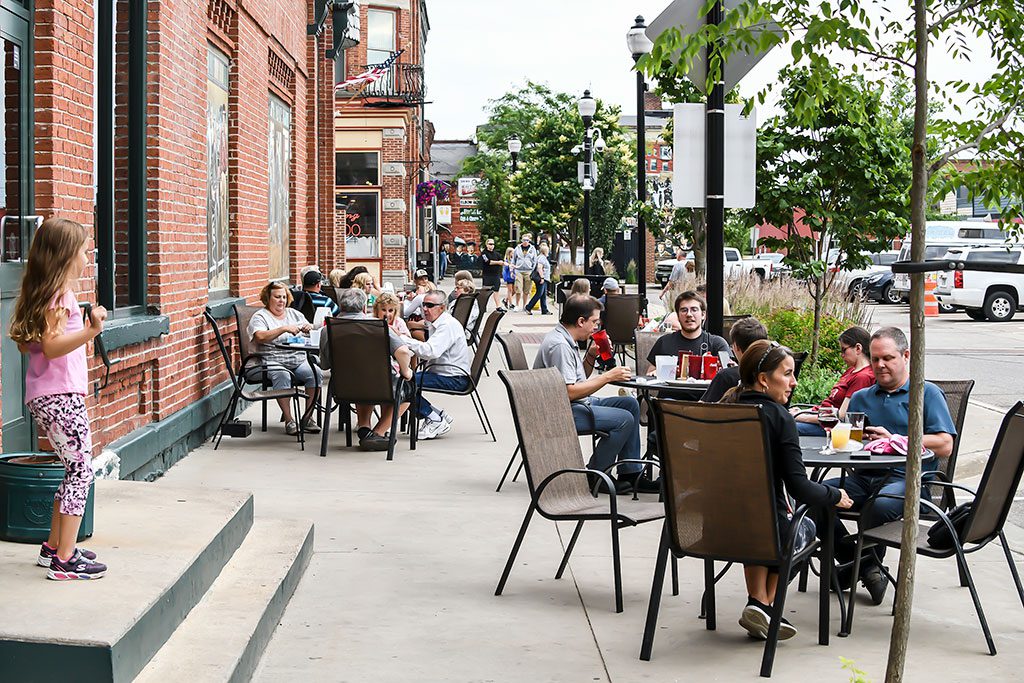
Downtown Stevens Point is vibrant during the Notes@Night event.
May 2023
By Errin Welty, Wisconsin Main Street
Community leaders often ask what they can do to make their downtown business district more vibrant. There is no surefire solution that will work for every community—each downtown has its own personality and unique landmarks. However, there are some common elements that thriving business districts share.
Consider which of these features might help raise your community’s downtown to the next level.
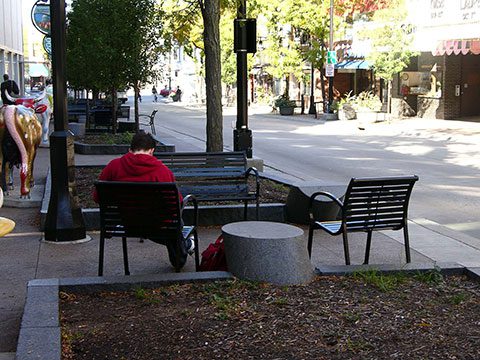
Wide sidewalks, tree canopy and well-placed benches encourage people to explore downtown.
Good downtowns are easy for pedestrians to stroll and explore. That requires ample sidewalks and a pleasant environment for walking, where pedestrians feel separated from traffic and have safe intersections and designated street crossings. Beyond those basics, people-centered districts will also have:
- At least one place with benches facing each other, or better yet, movable chairs that allow visitors to sit and talk. Benches should be available throughout the district for those who want to rest or who may be waiting for others to join them.
- A public gathering place that’s accessible year-round, with various seating options. Sunny seats and shady corners, quiet locations for reading, and seats with a view of the action are among the options available in the best-designed public spaces. Public gathering places also play an important role by offering a place to spend time that doesn’t require spending money. Water features, giant games, and people-watching can all be enjoyable activities that cost nothing but give visitors a reason to extend their stay downtown.
Districts that attract people provide things that meet their basic needs, encouraging them to visit more frequently and stay longer. In deciding how to address these needs, you might apply the perspective of Maslow’s hierarchy of needs, a framework created by the psychologist Abraham Maslow to capture the notion that people can only focus on higher-order needs—such as intellectual and spiritual fulfillment—once their basic survival needs—such as food, shelter, and physical safety—are met. Consider the most basic of needs visitors might have: eating, drinking, resting, and restrooms. To meet these needs, good districts have:
- Public restrooms and drinking fountains. Visitors staying any length of time will eventually need something to drink or to use the restroom. If these amenities are not available, visitors will leave the downtown area. Many communities provide public restrooms, either as standalone facilities in downtown parks or by clearly identifying buildings (such as libraries, museums, or government buildings) that offer public restrooms.
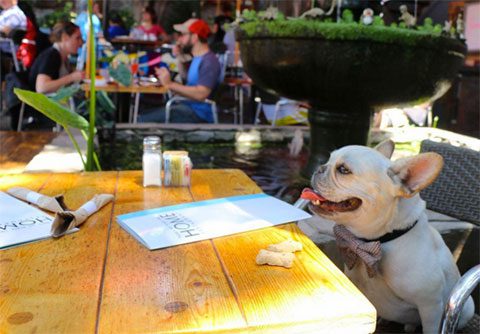
Outdoor dining increases capacity for existing restaurants, adds vitality on the street and can also accommodate four-legged visitors to the district.
Designated facilities for pets are also becoming important amenities. More residents and visitors are taking their dogs along when they go downtown, and dogs need water and a place to run around. Downtown dog parks are growing in number, and dog water bowls or fountains can be provided by individual businesses or in public spaces.
- A place to eat meals. Visitors will eventually need to eat. In fact, the No. 1 way to capture additional spending from visitors—other than enticing them to stay overnight—is to feed them. Enjoying a meal significantly extends the amount of time people will spend in your district, which, in turn, increases the distance that they are willing to travel to visit your downtown. In a 2017 business survey, restaurants were the only category of business where extended hours nearly always resulted in increased revenue. While shops may not be open early or late, having dining and/or drinking places that are open during those hours offers visitors a good reason to stick around longer.
In customer surveys across the state, outdoor dining is consistently the No. 1 amenity that people look for in a downtown district. Providing outdoor dining areas also makes the district look more vibrant. In addition, outdoor diners may spot nearby businesses that pique their interest, prompting them to patronize the shops and spend more money downtown.
The best downtowns look inviting to visitors. The visual cues provided by people-centered design and ample public amenities go a long way toward making visitors feel welcome. Posting a formal welcome sign—or two or three—can also be helpful to let visitors know they’ve arrived in the district, and wayfinding signs can direct them to important destinations to ensure their visit is comfortable and easy to navigate.
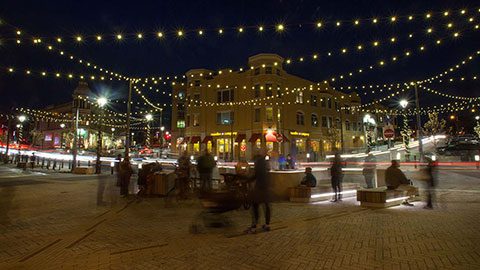
Wauwatosa’s use of lights creates a welcoming environment while flexible seating encourages visitors to extend their stay.
In addition to these traditional and more formal welcoming elements, vibrant downtown districts think about what visitors will experience during all seasons, day and night. Consider adding:
- Night lighting. Many visitors come downtown primarily at night, and in the winter months, it gets dark early in the evening. Ensuring that the district is well-lit makes pedestrians feel safer, creates visual interest, and highlights businesses that are open, making it easy to navigate the district after dark. (See our August 2022 INtersections blog post on district lighting to identify ways your downtown could boost its nighttime appeal.)
- Year-round touches of nature. While urban centers aren’t thought of as nature areas, having natural elements around makes visitors feel more comfortable. In addition to adding shade and color, nature is calming. Many communities have tree-lined streets, flower pots, or planters that provide some greenery to break up the span of concrete, but truly vibrant communities offer additional opportunities for a connection with nature. Designing spaces to be flexible depending on the season—such as allowing sunlight in during cooler months and providing shade in the heat of summer—or adding barriers to block gusty winds will increase the comfort of visitors throughout the year.
Fire and water are elements that entice visitors to explore and linger. That could involve installing fire pits to add warmth during colder months, while water features—especially those that encourage interaction and touch—add pleasant noise and visuals and make hot days feel cooler.
Unique and memorable elements
Downtowns are all different, and vibrant downtowns maximize their unique assets in ways that draw attention to the historical characteristics, outstanding public and private architecture, arts and cultural assets, and nearby natural elements. Make sure that your district is memorable by incorporating:
- At least one place suitable for wedding photos. An eye-catching and inspiring backdrop for photos not only encourages visitors to make the district part of their special memories but also offers creative inspiration. Compelling places invoke an emotional response that makes people relate more deeply to them and remember them more fondly.
- Unexpected discoveries. Downtowns are constantly growing and changing with new businesses, property renovations, and public space enhancements. The best districts are those where visitors can always expect to find something new. These changes can occur in either public or private spaces but should be coordinated to ensure that novel experiences abound. Examples might include businesses committed to updating storefront displays regularly, rotating outdoor merchandising displays, and posting creative sandwich boards. Public projects could feature pop-up events or pop-up shops, rotating displays in vacant storefronts, micro-art or transient art (e.g., art that appears only during the rain or when the sun is at a certain angle to cast shadows), street buskers, or any other unexpected element.
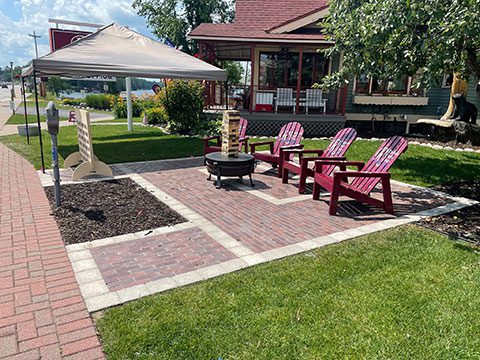
This real estate agent in downtown Minocqua welcomes visitors into their front lawn to enjoy seating and games while visiting the district.
A vibrant downtown is first and foremost a hub for commerce and economic activity. While theater performances and public events may draw crowds at specific times, the unique local shops and signature restaurants are the stalwart establishments people keep coming back to—places where they know the owners, enjoy shopping or dining with friends, and bring visiting guests to show off their community.
To be a true center of commerce, vibrant districts offer:
- A place to buy the basics. Similar to the need to offer basic amenities, an economically prosperous district allows visitors to purchase convenience and necessity items—coffee and snacks, diapers and deodorant, jackets and umbrellas—without leaving the area. Whether an overnight guest forgets a crucial item, a worker has a wardrobe emergency, or a traveler wants a cup of coffee for the road, businesses within the district should be able to meet those needs.
- Places that are open evenings and weekends. A truly vibrant downtown offers opportunities for socializing and spending during evenings and weekends, when most working people are available.
A common rule of thumb for a good mix of businesses is that one-third offer something to purchase, one-third offer drinking or dining, and one-third are open evenings and weekends. However, beyond those ratios, downtown businesses can step out of their standard roles to attract patrons. For example, salons and spas can highlight retail products; real estate offices or banks may offer coffee, snacks, or public patios to welcome current and prospective customers and galleries or museums might offer extended hours on certain days.. Meeting these criteria does not necessarily mean recruiting new businesses to your district, but it may call for persuading existing businesses to consider new ways to complement and grow their customer base.
Hopefully, this list offers ideas that are appropriate and achievable in your community to help create a visibly prosperous downtown business district that attracts a wide variety of visitors. Conducting an audit of your district using these guidelines is a good exercise and can uncover hidden opportunities for growth. Awareness is the first step toward a solution.
